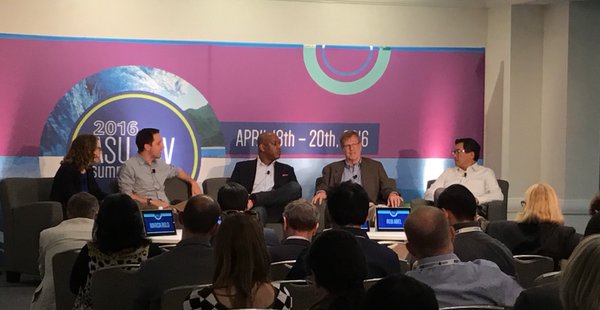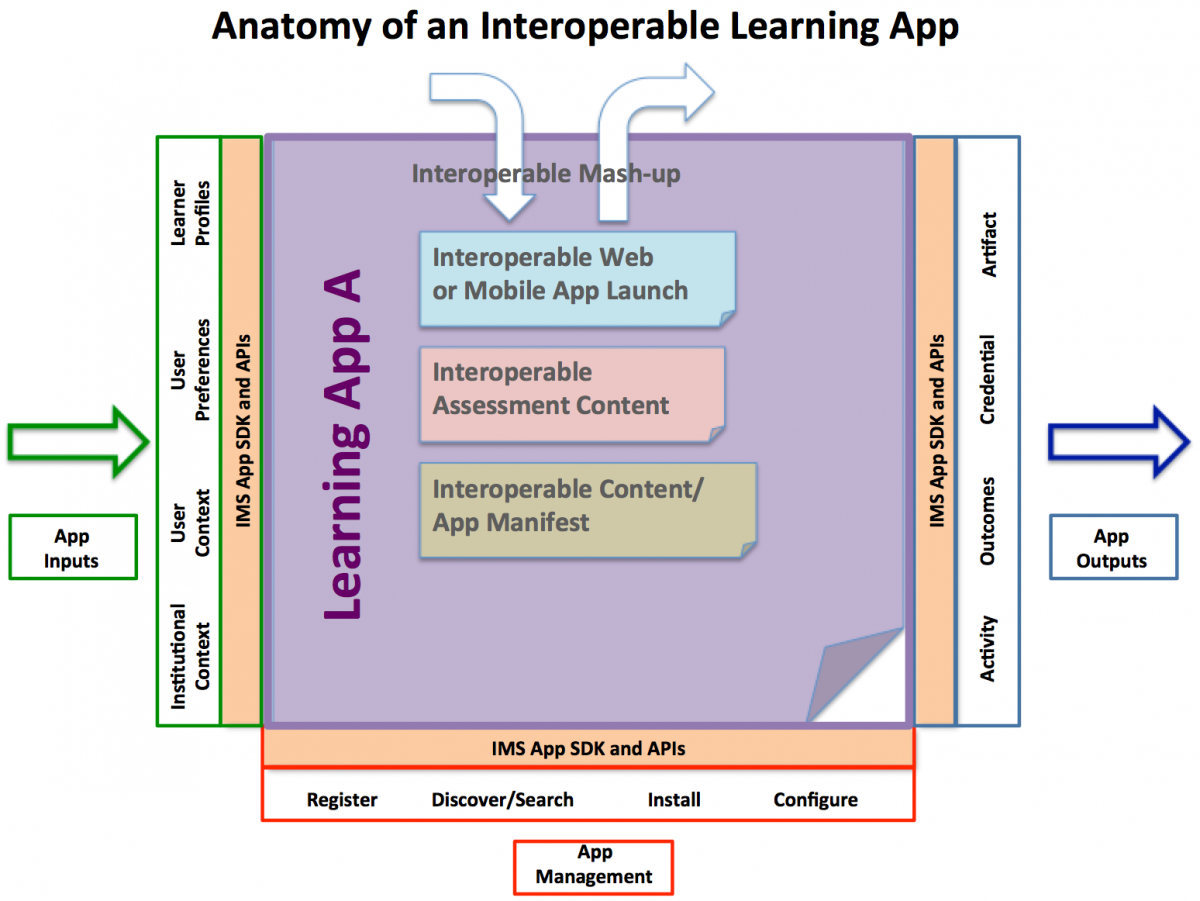#5 of a series in preparation for May 2016 Learning Impact Leadership Institute
After a 1-week pause to focus on the release of the 1EdTech Annual Report, I’m back at the topic of the anatomy of an educational or learning app.

In the previous post of the series I provided a high level overview of the interoperable inputs that an educational app might utilize. Now it’s time to look at the outputs.
It is interesting to note that last week I was on a panel at the well-known ASU GSV Summit entitled, “Why Can’t We Be Friends: Vendor Interoperability in Districts.” The salient takeaway for this post is that there was great agreement that while the sector is making some pretty clear progress on the input side of interoperability, the output side is pretty early in its development. So, get ready for the harder part!
As with my discussion on the inputs I am going to refer to the Anatomy of an Interoperable Learning App figure shown here. And, I am going to focus on what makes these outputs “next generation” in comparison to today.
 For next gen learning apps the objective is to enable better information outputs to understand progress, further personalize the learning experience and just in general understand the usage of various digital resources. Shown in the figure are some categories of potential outputs (on the right hand side) that are discussed further here:
For next gen learning apps the objective is to enable better information outputs to understand progress, further personalize the learning experience and just in general understand the usage of various digital resources. Shown in the figure are some categories of potential outputs (on the right hand side) that are discussed further here:
Activity: Some 1EdTech members call this aspect of digital resources “adoption.” As we evolve into the next generation of scaling the number and types of digital educational resources and applications one of the first questions that needs to be answered is, “Are teachers and students using these resources?” One function of this is for administrators, teachers and suppliers to get an understanding of what is being used, and perhaps be able to infer why or why not? One of the major deficits of research into use of digital resources is the dependence on user surveys. It is much better to have ways to directly measure usage. And, once usage can be measured accurately it enables the potential that use of specific resources or combinations of resources may be statistically correlated with outcomes via various assessment mechanisms. Activity information is also very important to the content creators/publishers because it enables a better understanding of how digital resources are being used and thus provide clues for improvement.
Outcomes: The most effective educational platforms and apps will be those that can indicate to the student, parent and teacher how well the learning is progressing. Of course, the term “outcomes” can have a very broad definition in education. However, the thought here is that the educational application will have some way to report progress, including scores to measure success on a specific activity, “gradebooks” that are compilations of scores, and even comparisons to the progress of other users. The challenge is that different applications will measure progress differently, and thus be difficult to compare and analyze. From the perspective of interoperability, one potential big win is a usable way to collect all the progress information on a single student on a single screen or other usable interface. Today, many tools may have various progress reports or dashboards, but they are resident “inside the application” and thus not readily looked at in conjunction with progress information from other apps. Another big win is agreement on some common summary information across a wide variety of learning applications. The holy grail perhaps, depending on your view of the viability of common learning standards, is an agreed upon approach for all apps and platforms to report on progress by specific learning standards. Finally, another very important type of outcome data in education is assessment “item data,” which is the collected responses to assessment items.
Credentials: There’s a lot of talk these days about the potential advantages of micro-credentials in education. Micro-credentials are ways to recognize granular achievements or cross-curriculum competencies that are highly valuable and typically not inferred by a higher-level construct such as a course grade or GPA. Such achievements or competencies may be extremely valuable in matching a person to a job or career. In the educational context, micro-credentials might do a much better job than grades in determining if a student is “college ready” in terms of meeting specific prerequisites. In the context of next generation digital learning there is the distinct possibility that a learning application may provide evidence toward a defined micro-credential or even a validation of such a credential. The interoperability that will be required will be a way to combine or mash-up such credentials. 1EdTech is working to apply open badge extensions and modular electronic competency and transcripts to enable credential validation and mash-up. The current state of the market is quite early and exploratory. So, we have a long way to go – but this is very important work for the future that may find useful application in those institutions that are doing a better job at micro-credentialing and competencies.
Artifacts: This very important area of next generation learning is potentially related to credentials. It is about how to capture, in an effective manner, what the learner may have created during their interactions with the application. While an artifact is not a credential, it can provide evidence of competency, creativity, agency, etc. The ability to capture meaningful artifacts can help a learner reflect on and assess their own learning, reinforce past learning experiences and display their work to others. An e-portfolio is a type of learning app that is designed for this purpose. But, artifacts can be created in many other types of learning applications and platforms. Next generation learning requires not only interoperable publishing mechanisms, but also interoperable metadata to enable classifying, sorting and searching artifacts.
Ramifications on Next Gen Architectures
From the above, one can see that there are a broad range of possible outputs from learning applications and platforms. As previously noted, interoperability of the outputs of learning applications is a complex topic that needs a lot or work. It is also much more variable across different educational levels and types than the inputs. Highly variable areas that are early in their maturity are usually not good topics to attempt to get industry agreement on. Therefore, we can reasonably make some conclusion regarding interoperability of outputs for next generation learning
- Interoperability of activity, outcomes and credentials will need to be structured to enable affordable collection of data that supports research on potential correlations.
- A very high-level of cooperation will be required among suppliers of a wide range of products to establish the interoperability standards and enable the data exchange to achieve #1.
- For #1 and #2 to accelerate understanding of the impact of learning apps and platforms, industry must set up and sustain funding models for cross-industry research.
- There will also need to be some “quick win” areas for interoperability of outputs. There are some ideas for such quick wins in the descriptions of the categories of outputs above. By “wins” I mean providing value to institutions, users and suppliers. Another way to state this is that “the road of establishing the interoperability for next generation learning must provide current generation benefits to all market participants.”
Next up in the series: What education sector realities are telling us about the likely evolution toward next generation digital learning architectures?


